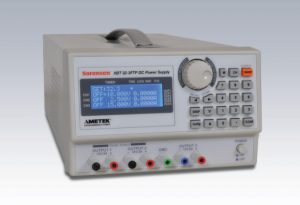Test bench power supplies, like the Sorensen XBT Series, are more than just power supplies. They are versatile test instruments that you can use to make your life simpler. Here are four things that you can do with Sorensen test bench power supplies that just might make your tests more effective.

1. Connect supplies in series for more output voltage.
The Sorensen XBT provides three separate supplies in a single instruments. Two of the supplies can be programmed to output 0 – 32 VDC at up to 3 A. The third supply can output 0 – 15 VDC, 0 – 5 A, up to a maximum of 30W. But, what can you do if you need to supply 48 VDC to a test circuit? The answer is to connect the two 32 VDC supplies in series.2. Connect supplies in parallel for more output current.
You can do something similar if your application requires more than the 3 A that a single output of the XBT can provide. Instead of connecting the two supplies in series, however, you connect them in parallel. When connected this way, the XBT can supply up to 6 A at voltages up to 32 VDC. The XBT allows you to set this up via the front panel and connect to a single set of output terminals. This is more convenient than using patch cords to connect supplies in parallel and reduces the opportunity for human error.
3. Computer control for consistent ramping.
A common thing a design engineer might do with a test bench power supply is ramp up or down a supply voltage to see how a circuit or system works over a range of supply voltages. You could do this manually by simply cranking up or down the voltage control, but if you do this programmatically, you can have the supply output a ramp with a consistent slope. You might also have the computer controlling the supply monitor the circuit or system under test for proper operation, and when it detects some abnormal operation, suspend the ramp and make note of the voltage at which problems started to occur
4. Computer control for sensor simulation.
Many sensors, such as the TMP35 low-voltage temperature sensor outputs a voltage proportional to the ambient temperature. They are used in a wide variety of applications, including environmental control systems, industrial process control systems, and fire alarms. Generally, temperature sensors like this output 10 mV/°C.
To test circuits and systems that use these sensors, you can use a programmable test bench power supply to simulate the sensor. The temperature profile might be a simple ramp as in tip #3, or a more complicated temperature profile. In either case, you would use the remote control capability of the XBT supply to program the temperature profile.
These are just some of the ways that you can make your test bench power supply jump through hoops. For more information on test bench power supplies and how to use them, contact AMETEK Programmable Power. You can send e-mail to sales.ppd@ametek.com or phone 800-733-5427.




